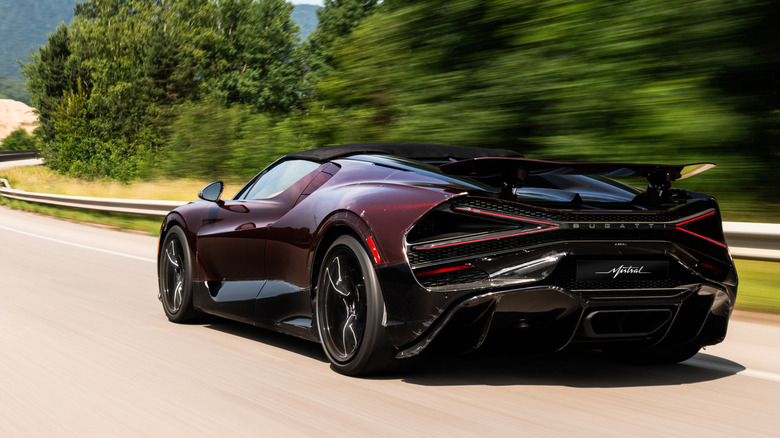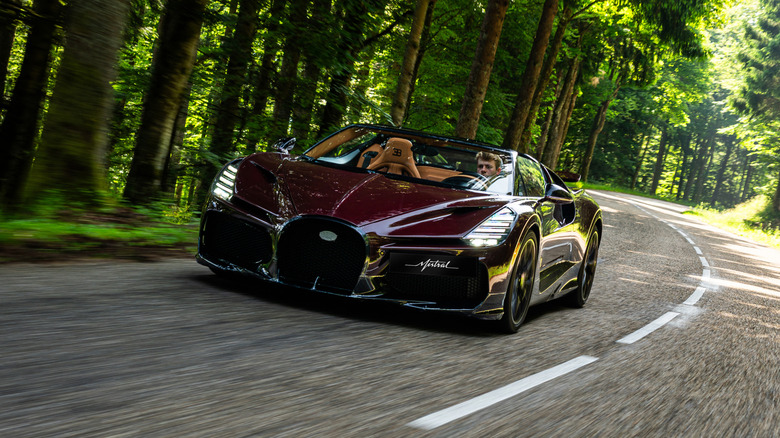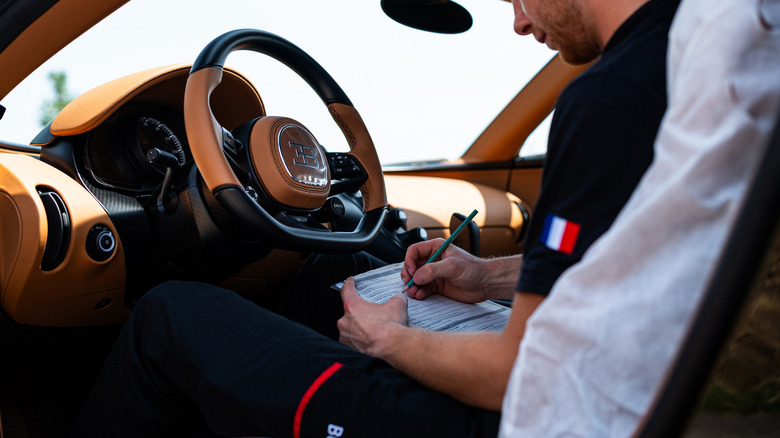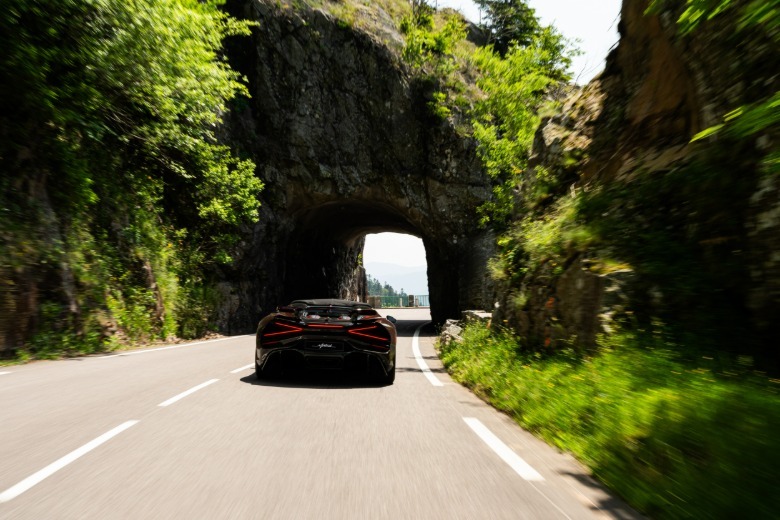
New cars typically have a handful of miles on them when they reach the dealership, like from driving off the factory lot onto a cargo ship or semi trailer, and many high-performance and high-end models undergo some amount of low-mileage real-world testing before delivery. It's also common for performance cars to require a break-in period after you've taken delivery, rather than wringing the powertrain out as hard as you can immediately. But as with so many other aspects of its vehicles, Bugatti takes
the pre-delivery testing above and beyond, and the W16 Mistral's testing regime is the brand's most rigorous yet.
Bugatti has a 217-mile test route through Alsace that "includes traditional Alsatian villages, winding country roads that showcase the W16 Mistral's agility, long highway stretches intended to evaluate stability and comfort during sustained cruising, and mountain passes that challenge the powertrain under range of elevation and atmospheric conditions," the fairly obsessional automaker says. After that, further testing is done to make sure every aspect of the car is absolutely perfect. Then Bugatti's test drivers take it to the Colmar airfield where they test out the stability control and brakes — and hit 186 mph on the runway. In all, every new Bugatti covers at least 250 miles before a customer ever takes delivery. That brings new meaning to the phrase "delivery miles" or "never driven."
Read more: These Supercars Lose Value So Quickly, They're Almost A Steal
The Landscape Is Used To Bugatti's Advantage

That diverse route "reflects the full spectrum of real-world scenarios a customer may encounter," such as cobblestones that could reveal a minor chassis irregularity. Every component is individually scrutinized along the route, from the steering and transmission to the interior features and build quality. As the Mistral is a roadster with only a fairly basic manual soft top for emergencies, it undergoes a bunch of convertible-specific testing, too. They check its fit, removal process, and high-speed resistance — Bugatti hasn't said how fast the Mistral can go with the roof on, but I'm sure it's a bit less than the record-breaking 282 mph it hit with the roof off.
The Mistral's quad-turbo W16 sounds like nothing else, and Bugatti has carefully engineered it that way. Noise testing includes "evaluation with and without the soft-top roof, analysis of wind and road noise characteristics, assessment of the exhaust system's acoustic signature, and verification of chassis and tire rolling dynamics," and Bugatti says "every facet of the surrounding environment is also employed in the pursuit of perfection – down to narrow streets lined with ancient stone buildings, which create natural acoustic chambers for Bugatti's test drivers, using the echo against walls to analyze every nuance of the vehicle's sound profile."
It's Important For Humans To Do Bugatti's Testing

Bugatti says there are only three specialists that have both the qualification and dedication to do the W16 Mistral's evaluations, and they represent decades of accumulated knowledge. Every new test driver's training includes "several supervised test drives alongside senior experts, and fully autonomous assessments encompassing comprehensive sensory analysis." Having so much of this testing by done by an expert human is crucial, says Bugatti:
This human-centric approach reflects Bugatti's fundamental methodology: ninety percent of quality validation derives from the driver's personal analysis through sight, sound, and touch. These automotive virtuosos possess the ability to detect the slightest irregular sound, identifying unknown vibrations imperceptible to untrained senses that could indicate developing issues. Their profound mechanical understanding, borne from extensive skill with every component, enables accurate detection and diagnosis of any anomaly.
Each observation is meticulously recorded via dictaphone during the drive for subsequent in-depth analysis, and when necessary, followed by partial or complete vehicle disassembly. The remaining ten percent of evaluation utilizes sophisticated electronic diagnostics, a combination of Bugatti's proprietary internal telemetry systems and highly precise data loggers that continuously monitor and record all performance metrics throughout every kilometer of the test drive.
If any irregularities or imperfections are found anywhere in the car, no matter how minor, after the problem is resolved the car will undergo at least another 31 miles of testing to make sure the issue is eradicated. Bugatti says that process will go on for as many cycles as is necessary "until the vehicle demonstrates flawless performance under every conceivable condition."
It's All For Peace Of Mind
That should definitely give peace of mind to the people dropping at least $5 million on one of the 99 Mistrals that will be built. Would you rather your new hypercar show up with just 5 miles on it, or a few hundred miles but with absolute proof that it is flawless and can achieve all of the absurd performance claims that Bugatti boasts? Says Christophe Piochon, president of Bugatti:
Putting every vehicle through a minimum of 400 km of assessment, our evaluation protocol isn't just about validating functionality, but a confirmation that each W16 Mistral is imbued with the pure essence of quality, precision, and craftsmanship that makes a Bugatti truly extraordinary. It is a process that has been meticulously refined over 20 years; I had the opportunity to help design the 350 km test for the Veyron during its development, and saw it evolve into the assessment optimized for the Chiron and its derivatives. Now with the Mistral, we're proud to see the continued success of this process - reaffirming the quality and reliability of our vehicles for our customers.
There is a huge benefit of this testing regimen to us normal people that won't be receiving a new Bugatti. As all of this Alsatian testing begins and ends at Bugatti's Molsheim headquarters, car enthusiasts are able to post up outside the main gate, at the test track, or on public roads to catch glimpses and take photos of new Bugattis undergoing these pre-delivery tests, and older models that are in for service. (Here's one of my favorite pages for that.) That's especially nice when, despite all of the rigorous testing, some of these cars will just sit collections, never to be taken out on public roads again.
On-road testing of the V16 hybrid Tourbillon is underway, and with first customer deliveries set to commence at some point next year, hopefully we'll start learning about that car's surely even more extensive testing regimen soon.



Want more like this? Join the Jalopnik newsletter to get the latest auto news sent straight to your inbox...
Read the original article on Jalopnik.











